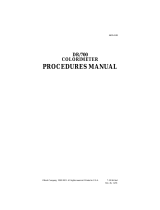
1—4
Table of Contents, continued
Molybdenum, Molybdate, LR.........................................................................1—33
Measuring Hints................................................................................................1—33
Sampling and Storage......................................................................................1—38
Accuracy Check.................................................................................................1—38
Interferences......................................................................................................1—38
Summary of Method.........................................................................................1—38
Replacement Parts.............................................................................................1—38
Molybdenum, Molybdate, HR.........................................................................1—39
Measuring Hints................................................................................................1—39
Sampling and Storage......................................................................................1—44
Accuracy Check.................................................................................................1—44
Method Performance........................................................................................1—45
Standard Calibration Adjust Method..............................................................1—45
Interferences......................................................................................................1—46
Summary of Method.........................................................................................1—49
Ozone.......................................................................................................................1—53
Measuring Hints................................................................................................1—53
Sampling and Storage......................................................................................1—58
Stability of Indigo Reagent..............................................................................1—58




























